Interviews
Bob Mcleod Returns
By Leroy Douresseaux
August 6, 2005 - 06:40
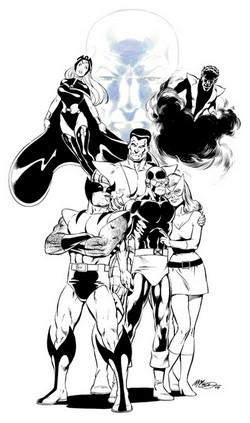 |
| Bob's stunning illustration for a Dave Cockrum tribute book |
Welcome to the conclusion of our extensive interview with
Bob McLeod, veteran comic book artist, best known by many for his virtuoso inking on several popular series in the 1980’s and 90’s. Many also know him as the co-creator of Marvel’s
New Mutants, along with writer Chris Claremont and editor Louise Simonson (then Louise Jones). By next Spring, he may be known as a children’s book author and illustrator after
Superhero ABC from HarperCollins hits the shelves. The first part of the interview was entitled
BOB MCLEOD - OUT OF THE SHADOWS for those who want to read it:
If we can backtrack a little, you did some work for PLAYBOY magazine, a strip called "Singlewoman." How did that come about, and did you have some concerns about what you were going to draw? Or was it a pretty mundane job?
BOB: Another artist at Continuity,
Frank Cirroco, had drawn a Singlewoman strip for a magazine called INTERNATIONAL INSANITY, and was too busy to do another one. So he suggested my name to the writer, and I agreed to draw it (1)because I needed the work and (2)it was pencils and inks and (3) the writer was a cute blonde (I was still single at that time). She then met the Playboy cartoon editor at a party, and got the gig at Playboy. We were supposed to do the strip every month, but we had been dating, and after two strips we broke up and didn't want to work together any more. Also, though I was initially excited to be offered work by a high profile magazine like Playboy, I decided I didn't really want to be doing work that embarrassed my parents .
After leaving New Mutants, you certainly had an active career as an inker and as a penciller. For instance, you pencilled Marvel's Star Wars comic for a while. How did you land that gig? Did drawing such famous characters present a lot of problems creatively and practically – especially since (I'm assuming) Lucasfilm, Ltd. plays close attention to what licensees are doing to the characters?
BOB: I don't really remember what led to that job. I was looking to do more pencilling, and I inked an issue of STAR WARS over
Ron Frenz, and probably asked the editor if they had any other work, and they gave me a fill-in to pencil and ink, and then offered me the monthly book to pencil. Lucasfilm was a pain to work with, but mostly just on the scripts, not the pencils. I was fortunate to have my favorite inker,
Tom Palmer, giving the art great finishes.
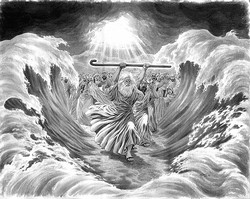 |
| Bob's stunning Biblical-themed ink wash commission for Scott Simrall |
You inked Mike Zeck on one of the most popular Spider-Man storylines of the 80's - Fearful Symmetry: Kraven's Last Hunt. How did you get that project? You inked Zeck again on a sequel to that project (Soul of the Hunter). Did the two of you work closely together? I think you made him look much better than he did in the debacle that was Secret Wars.
BOB:
Mike Zeck is a friend, and I was one of his favorite inkers from the time he first started in comics because he said I inked him close to the way he would ink himself. I had inked several of his covers.
John Beatty is also a friend of Mike's (and mine), and he and John were a regular team, but I think Beatty was busy on another project when the Kraven series came up. SECRET WARS was a huge mess due to Jim Shooter, rather than Mike and John. That's a long story you need to talk to Mike about.
After New Mutants, Star Wars, and Spider-Man, I lose track of what you did for the rest of the 1980's. What were you doing?
BOB: I inked 6 issues of JEMM, SON OF SATURN over
Gene Colan, for DC after
Klaus Janson bailed out of the series. I pencilled and inked a fill-in on POWER PACK for my friend
June Brigman, inked a couple issues of SPITFIRE (one over [Herb] Trimpe, one over McFarlane), and inked a lot of GI JOE covers. I then inked several issues of WONDER WOMAN over [George] Perez breakdowns, then inked several issues of the NEW TITANS over Perez breakdowns, inked a NEW MUTANTS ANNUAL over Brigman breakdowns, inked New Mutants #75 over [John] Byrne breakdowns, and then inked that horrible 12-issue SUB-MARINER series over [Rick] Buckler, which almost stalled my career again. That's when I decided to move back up north to rejuvenate my career, and being back in NYC made a big difference in the assignments I got. I started inking the HULK over
Dale Keown, then quit that when I got an offer to pencil SUPERMAN.
I do remember you inking the early part of Todd McFarlane's run on Amazing Spider-Man (beginning with issue #298), which came out in the late 80's (maybe around 1989). That collaboration didn't seem to go well. For one thing, you didn't seem to pick up all those squiggly lines (what those dummies call " the detailed look") and cross-hatching McFarlane seemed determined include in his drawings. Did it occur to you at the time that McFarlane was trying to ape Michael Golden? Or were you simply unwilling to play around with unnecessary "detail."
BOB: I was supporting a family and it was about money. Todd was pencilling sloppy breakdowns and getting a full pencil rate, causing me to get a lower ink rate ($550 a month less in 1988 dollars!). I put a lot of time and effort into the Spitfire job, so Todd loved it, but when I got his dreadful Spidey scribblings, I'd had enough, and decided to ink it cleaner and faster since he was ripping me off on the page rate, and since none of his ridiculous rendering made any sense anyway. He complained and I gladly quit after 2 issues.
Related to working with McFarlane: There did seem to be a band of GenX artists that arrived in the late 80's, most of the artists without much in the way of storytelling abilities or even good draftsmanship. They pretty much wanted to ape their favorite artists' drawing style. Most them did a rip off Michael Golden, or at least Art Adams’ version of Golden and also, to a lesser extent, Frank Miller circa Dark Knight.
Did you notice that change in the kind of young "artistic talent" that came in the late 80's, or am I generalizing? Did other artists of your age or generation talk much about the guys that became hot at Marvel in the late 80's and early 90's and went onto form Image?
BOB: Sure. Because of mainly McFarlane and Rob Liefeld, the new guys coming into comics got the rep of being all flash and no substance. They often didn't draw backgrounds; they didn't know storytelling; and their figure drawing was weak. When I drew Peter Parker, he had to look a certain way or [John, Sr.] Romita would re-ink the heads. Todd's Peter Parker and Mary Jane usually looked very little like the traditional characters. There was a consensus among the older artists that industry standards had reached a new low, and that much of the work being published was not really at a professional level.
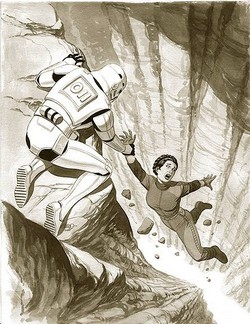 |
| A Star Wars ink wash commission for the collection of Walt Parrish |
I guess this group of questions could be our back in the day segment. You mentioned in a prior conversation that there was a point sometime in the late 70's, when the atmosphere at Marvel changed, perhaps the environment became less friendly and stricter. What was it like working at Marvel when you began in 1973? Was there a point when things became more formal? Why do you think there was a change in attitude?
Some have said it was Jim Shooter becoming editor-in-chief. Others have speculated that as Marvel's corporate parent began to realize how much money they could make from comics publishing (maybe in part because of the just-arriving Direct Market), they clamped down and wanted a tighter ship oriented towards making more money and not necessarily comics that were fun to read.
BOB: This is all hard to remember. When I started in '73, Marvel was a very small, informal place where anyone could almost just walk in and out as they pleased. Few people were making big money, so most everyone was working there because they loved comics. Many of the younger production people and editors at Marvel and whatever freelancers were around used to go to Central Park after work and play volleyball or softball. Stan Lee even pitched at a game or two. We had an indoor volleyball league, with people from Marvel and DC on the same team playing against other magazine publishers. I can't imagine that kind of stuff going on today.
Things changed gradually. A couple people walked out of Marvel with dozens of pages of original art that didn't belong to them at one point, and suddenly Marvel had to change their open door policy. A couple freelancers started hanging around the editors’ offices annoying people and being disruptive, so suddenly we had to state which editor we had business with, and have them meet us at the door, instead of just going up and seeing who was around and who needed an artist. I personally never had a problem with Shooter. I felt like he always tried to pay the artists as much as he could. But he did have a very rigid idea of how comics should be done, and it was not a good way, creatively.
The direct market was great in the beginning, but really ruined the industry, in my opinion. It eliminated the mass market buyers, and catered only to the ever-shrinking, aging fan base. It led comics to be written more for (immature) adults only and less for all ages. And once the publishers and artists discovered big money could be made, the whole business became driven by the bottom line, which is very detrimental for a creative business.
Marie Severin once commented in an interview with the Comic Book Artist magazine that the way comics were made changed when the fans started coming in as creators. I imagine that would include Shooter, Roy Thomas, Claremont, etc. When you went into the business, especially from your perspective of not being a super hero fan, did you notice a generation gap in the way comics were conceived, written, drawn, lettered, colored, etc. both in the Marvel office and outside in the freelancers world?
BOB: Definitely. Originally, mostly 3rd rate artists drew comics, because there was so much more money and prestige in illustration and advertising. Comics were considered a ghetto business. But as the fans grew up and entered the business, they started writing stories to fulfill their own fantasies instead of just writing for kids, who were most of the audience. This has led to very violent, sexual comics, and almost the exclusion of comics for kids and young girls, and almost no humor in comics. Where are CRAZY, PLOP, BRAND ECCH, HERBIE, PLASTIC MAN, etc.? Where are all the Harvey comics? Neal Adams, renowned for adding realism to comics, entered the business drawing Jerry Lewis comics!
The new generations of artists started trying to do the best art they could, not caring whether they made any money. Which doesn't mean the older artists didn't try to do great work, but they were usually trying to make a living as well. The new, younger artists often lived at home or willingly lived in poverty in order to spend 16 hours a day or more on a single page.
Frank Giacoia, a wonderful artist, groaned when he saw all the detailed work Barry [Windsor] Smith was doing on Conan, because he knew that would become the new standard, meaning less money and longer hours for everyone. And many of the new artists were not well trained, and lacked a sound knowledge of the fundamentals of art, so their efforts were spent in adding more details and superfluous line work, creating art that often wowed the fans, but was in fact not on a professional level. Even the often denigrated old inker
Vinnie Colletta could draw rings around many of the new younger artists of the '80s and '90s.
Although children and juvenile readers have long been the audience for comics, there is anecdotal evidence that many adults read comics (including G.I.'s during WWII) and were happy with the juvenile content. Is it possible that the fans who became creators and wrote their own wish fulfillment and adult-oriented stories and their industry bosses did not realize that plenty of older readers, as well as children, might be turned off with what the new more violent and sexual content?
BOB: At the same time the fans became the writers and editors, another major change was happening. For whatever reasons, sales had been declining during the late 60's and early 70's, and the publishers decided to switch from the mass market newsstand returnable system of distribution to a system of "direct sales", with no returnables allowed.
Consequently, newsstands and magazine shops stopped carrying comic books. Suddenly, the only place you could buy a comic book was in a comic shop. As a result, the audience for most comic books became winnowed down to primarily just young males of a certain type. Most adult readers, pre-adolescent children, young girls and even many young boys are unlikely to go to a comic shop to buy comics. As a result, the type of buyer who would go to a dark, strange store with an unfriendly and often even hostile owner/clerk soon determined the type of comic that sold well, and it tended to be violent and sexy. All the humor comics, the Harvey line, the romance comics, etc. were doomed.
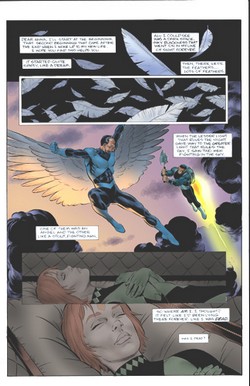 |
| The opening page of Sunset, a project in development |
Do you still have a desire to draw comics for Marvel and DC? If so, is it a desire driven by the need for employment or the need to draw comics featuring their characters... or something in between?
BOB: I have no desire to draw any particular character. I know this seems unimaginable to many fans, who would dearly love to draw Spider-Man, but I've drawn all of the major characters, and I was never a big superhero fan to begin with. I originally wanted to draw for Mad, remember.
The only reasons I would work for the major comics publishers would be (1) to make money, and (2) because I think I'm good at drawing and inking comic books. Marvel and DC have, whether deliberately or inadvertently, always stymied my attempts to do my best artwork. I'm not good on a short deadline, and I prefer to pencil and ink, rather than just doing one or the other. I also prefer to color my work, and I even enjoy lettering. I was only able to do it all once in 25 years at Marvel and DC (in Marvel's now defunct
Hulk magazine).
What makes you want to go back to comics and what are the things that make you want to stay away?
BOB: Everyone likes to do what they do well. I spent many years learning the craft of comic books, and I feel I do it well. There can be a great sense of satisfaction in drawing comics, because you can be fairly autonomous in the creation of the art and storytelling. I also get a lot of pleasure from inking good pencil art by another artist. Two artists working together can create art that neither one could create alone, and I think I have an aptitude for inking, which is an under-appreciated skill.
What I dislike about doing comics are the monthly deadlines, getting bad coloring, inking badly drawn tight pencils, having my pencils poorly inked, incompetent editors, and having to pencil bad scripts. I often had all of the above combined.
What does the future hold for you? You have a children's book due out perhaps by the end of the year. Is your career drifting towards book illustration and advertising art?
BOB: I do a lot of private commissions and some illustration jobs. I would like to do more children's books and more painting.
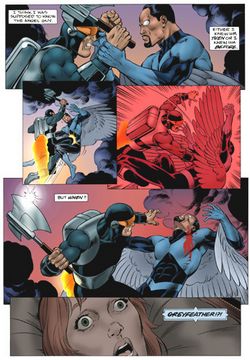 |
| Sunset, pg. 2 - pencilled, inked, colored, and letter by Bob |
Before we close out, what do you want to say to readers?
BOB: I'd encourage readers to look beyond superheroes and discover other genres of comics. My issues are mainly with the publishers, not the readers. Why aren't there more mainstream comic books for girls? Why isn't there more variety in genres? More variety in art styles? Readers need to write to the editors and let them know there's a demand for non-superhero comics.
THANK YOU, BOB. Bob currently draws select issues of
The Phantom comic book series, based upon the (very) long-running newspaper comic strip of the same name, created by Lee Falk; the series is published in Europe by Egmont. Bob inked some of DC/Wildstorm’s
Left Behind comics, which you may still be able to find as they were distributed to bookstores. Bob is busy with commissions; interested parties may visit his
website for more info on that.
Of course, his children’s book, SUPERHERO ABC from HarperCollins is due next February (2006), and he occasionally works as a commercial illustrator. Some time in the future, our dormant comic series, entitled “Sunset” will hopefully see publication.
Last Updated: March 3, 2025 - 20:40




